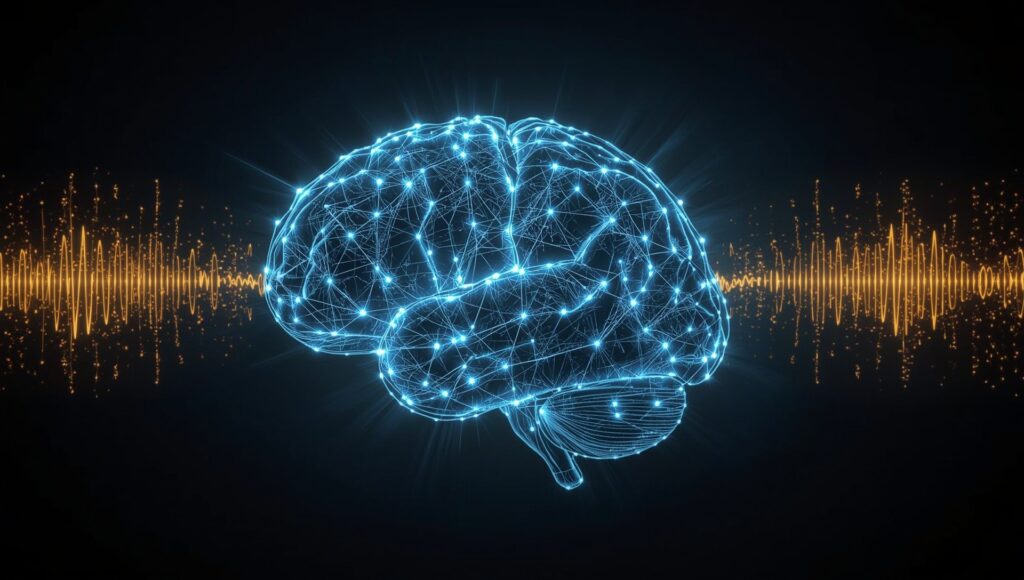// OPERATOR’S LOG: DEEP DIVE //
The modern world is a war for your attention. Every notification, every email, every distraction is an enemy trying to breach your walls. To do truly deep work, you need a fortress. For years, I’ve been obsessed with one question: Can sound be engineered to become the foundation of that fortress?
The answer is yes. But the “how” is more fascinating than I ever imagined. This isn’t about genre. It’s about neuroscience.
Read more: The Neuroscience Behind the NeuraShards SignalThe Foundation: The Yerkes-Dodson Law & The “Optimal Arousal Zone”
The relationship between music and performance isn’t linear. It’s a fundamental principle of psychology known as the Yerkes-Dodson Law, which describes an inverted-U curve of arousal.
- Too little stimulation (e.g., total silence or overly simplistic music) and your brain becomes bored, lethargic, and prone to mind-wandering.
- Too much stimulation (e.g., complex lyrics, aggressive tempo, chaotic structure) and your brain becomes overwhelmed, anxious, and distracted.
The sweet spot is what scientists call the “Optimal Arousal Zone.” This is the state of “flow” – where you are perfectly challenged, engaged, and operating at peak cognitive performance. The entire mission of NeuraShards is to engineer signals that guide your brain into this zone and keep it there.
The First Clue: The Power of Silence (Stanford, 2007)
A landmark study from the Stanford University School of Medicine in 2007, led by Vinod Menon, used fMRI scans to watch the brain as it listened to music. They discovered that music is a powerful tool for engaging the brain’s attention and prediction systems.
But their masterstroke discovery was this: the moment of peak brain activity, the highest point of focus, occurred during the short periods of silence between musical movements.
The brain uses these moments of silence to process what it just heard and predict what comes next. It’s in the quiet anticipation, the space between the notes, that the mind truly sharpens. This is the dynamic interplay between the signal and the void. A constant wall of sound is just noise. A structured journey with moments of quiet is a tool for focus.
The Second Clue: The Dopamine Trail (McGill, 2011)
So, how do we keep the brain engaged without distracting it? The answer lies in dopamine. A groundbreaking study from McGill University in 2011, led by Dr. Valorie Salimpoor, demonstrated that listening to enjoyable music triggers the release of dopamine – the “reward” chemical – in the same areas of the brain associated with food, sex, and addictive drugs.
Critically, the dopamine release wasn’t just about the “best part” of the song. It was about the anticipation. The brain, recognizing a pattern, gets a small “hit” of dopamine as it correctly predicts the next chord or beat.
This means that the ideal focus music shouldn’t be completely random. It needs simple, repeating, predictable patterns. These patterns create a “breadcrumb trail” for the brain, a steady stream of micro-rewards that keeps it engaged and motivated, without needing to consciously analyze the music.
The NeuraShards Protocol: Synthesizing the Data
This is where we connect the science to the art. Every “Golden Loop” we create is an attempt to engineer these principles into a functional tool:
- The Tempo: The genius of Chillstep is its dual nature. It has a fast 140 BPM rhythm (the hi-hats) that provides energy and triggers dopamine (the Beta wave state), but the underlying harmony and bassline move at a slow 70 BPM, providing a calm, meditative foundation (the Alpha wave state).
- The Structure: Our 1-hour loops are built on simple, repeating motifs. We don’t try to surprise you. We create predictable, hypnotic patterns that your brain can learn and follow, creating that perfect “dopamine trail”.
- The Atmosphere: We use vast, atmospheric pads and heavy reverb to create a sense of space. This is our implementation of the “power of silence.” The notes are not crowded. There is room for your own thoughts to breathe between them.
That’s all of the news for today, see you in the next one.
And as always, stay focused.
- N.
The Neuroscience Behind the NeuraShards Signal

Leave a Reply